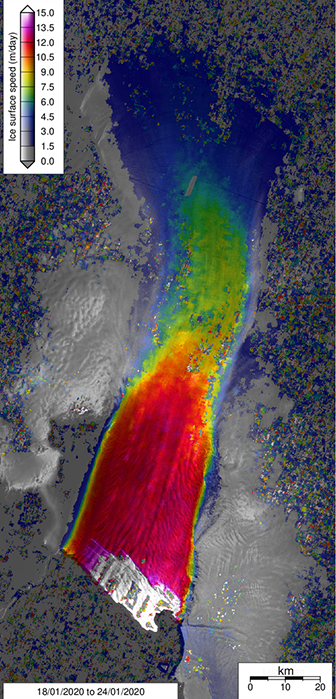NASA/AQUA/MODIS/A.LUCKMAN
A68 barely moved after calving, but this year has suddenly raced northwards
The world's biggest iceberg is about to enter the open ocean.
A68, a colossus that broke free from the Antarctic in 2017, has pushed so far north it is now at the limit of the continent's perennial sea-ice.
When it calved, the berg had an area close to 6,000 sq km (2,300 sq mi) and has lost very little of its bulk over the past two and a half years.
But scientists say A68 will struggle to maintain its integrity when it reaches the Southern Ocean's rougher waters.
"With a thickness to length ratio akin to five sheets of A4, I am astonished that the ocean waves haven't already made ice cubes out of A68," said Prof Adrian Luckman from Swansea University, UK.
"If it survives for long as one piece when it moves beyond the edge of the sea-ice, I will be very surprised," he told BBC News.

COPERNICUS DATA/SENTINEL-3/ESA/A.LUCKMAN
Europe's Sentinel-3 satellite shows A68 against the edge of the perennial sea-ice (orange line)
A68 split from the Larsen C Ice Shelf in July 2017. For a year, it hardly moved, its keel apparently grounded on the seafloor.
But the prevailing winds and currents eventually began to push it northwards along the eastern coast of the Antarctic Peninsula, and during this summer season the drift has undergone a rapid acceleration.
The iceberg, currently at 63 degrees South latitude, is following a very predictable course.
NASA/JOHN SONNTAG
A68 is about 150km long but only 200m or so thick. It has the profile akin to a few sheets of A4 paper stacked on top of each other. Rough seas should break it apart
Many of Antarctica's greatest bergs even make it as far - and beyond - the British Overseas Territory of South Georgia at roughly 54 degrees South.
The biggest ever recorded iceberg in the modern era was the 11,000-sq-km block called B15, which calved from the Ross Ice Shelf in 2000.
One of its last remnants, now measuring "just" 200 sq km, is halfway to the South Sandwich Islands, east of South Georgia.

S.BEVAN/SWANSEA UNI
Objects this big have to be constantly monitored because they pose a risk to shipping. Satellite images, like the ones shown on this page, are the obvious way to do this.

Image copyrightCOPERNICUS DATA/SENTINEL-1/ESA/A.LUCKMANImage captionPine Island Glacier in West Antarctica is about to release a big iceberg (white shading)
While they keep an eye on A68, scientists are also watching for two other, soon-to-birth bergs.
One is about to come off the front of Pine Island Glacier in the West Antarctic. This will be a little over 300 sq km when it calves. The block is already riven with many cracks.
"I expect that the new iceberg will break into many pieces soon after it calves," said Prof Luckman.
The other imminent large berg is forming in eastern Antarctica, on the edge of the Brunt Ice Shelf.
This should be about 1,500 sq km - roughly the area of Greater London.
The putative berg has garnered a lot of attention because Britain's Halley research station had to be moved to make sure it wasn't in harm's way.

The berg will calve when a big rift, dubbed Chasm 1, finally slices through a section of ice measuring less than 10km in length.
Precisely when, no-one can say. "The rift is widening, but only at a steady rate, and the rift tip is hardly advancing," Prof Luckman told BBC News.
COPERNICUS DATA//ESA/SENTINEL HUB
The Brunt berg will be about the size of Greater London when Chasm 1 breaks through



No comments:
Post a Comment
Stick to the subject, NO religion, or Party politics